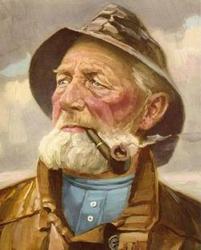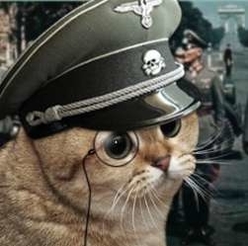Why are they black and red and why do fascists adopt them when they are fighting the black anarchists and red commies? Beside the fact they are martial colors as well as practical and fear inspiring.
I've heard many people claim that fascists purposefully adopt the colors to coopt their left wing revolutionary counterparts.
revolutionary colors
-
BjornP

- Posts: 3360
- Joined: Thu Dec 01, 2016 9:36 am
- Location: Aalborg, Denmark
Re: revolutionary colors
Can't answer the central point of the question, why fascists choose to adopt the colors, but the black and red flag (as in one triangle half red, the other triangle half of the flag black) is the anarcho-syndicalist flag. Syndicalists believe in achieving an anarchist society through the use of unions, that they can force the breakdown of both the State and the capitalist system through major national or international general strikes. Other anarchists just use an entirely black flag.TheReal_ND wrote: Wed Oct 03, 2018 7:54 pm Why are they black and red and why do fascists adopt them when they are fighting the black anarchists and red commies? Beside the fact they are martial colors as well as practical and fear inspiring.
I've heard many people claim that fascists purposefully adopt the colors to coopt their left wing revolutionary counterparts.
If I should hazard a guess: Trying to take over the symbols and terminology, and substituting it for your own, makes sense... in a post-modernist society like the US has become, at least. If everything is interpretation, it becomes about being the last man standing who is able to interpret. You can't interpret if you're dead.
Fame is not flattery. Respect is not agreement.
-
C-Mag

- Posts: 28389
- Joined: Tue Nov 29, 2016 10:48 pm
-
Montegriffo

- Posts: 18808
- Joined: Wed Nov 30, 2016 7:14 am
Re: revolutionary colors
I've always liked a green and black combination.
I might paint my truck that colour scheme.
I might paint my truck that colour scheme.
For legal reasons, we are not threatening to destroy U.S. government property with our glorious medieval siege engine. But if we wanted to, we could. But we won’t. But we could.


-
Hastur

- Posts: 5297
- Joined: Wed Nov 30, 2016 2:43 am
- Location: suiþiuþu
Re: revolutionary colors
British racing green is the ugliest race car color ever. Use that. It is better suited for a van.

An nescis, mi fili, quantilla prudentia mundus regatur? - Axel Oxenstierna
Nie lügen die Menschen so viel wie nach einer Jagd, während eines Krieges oder vor Wahlen. - Otto von Bismarck
-
TheReal_ND

- Posts: 26048
- Joined: Wed Nov 30, 2016 6:23 pm
Re: revolutionary colors
This was created on a argentina forum.
No one here read mein kampf or listened to Mosley or Mussolini talk about the fascist colors?
As long as the November outrage endures, that outrage may continue to bear its own external sign and not steal that of an honourable past. Our bourgeois politicians should awaken their consciences to the fact that whoever desires this State to have the black, white and red colours is pilfering from the past. The old flag was suitable only for the old Reich and, thank Heaven, the Republic chose the colours best suited to itself.
This was also the reason why we National Socialists recognized that hoisting the old colours would be no symbol of our special aims; for we had no wish to resurrect from the dead the old Reich which had been ruined through its own blunders, but to build up a new State.
The Movement which is fighting Marxism today along these lines must display on its banner the symbol of the new State.
The question of the new flag, that is to say the form and appearance it must take, kept us very busy in those days. Suggestions poured in from all quarters, which although well meant were more or less impossible in practice. The new flag had not only to become a symbol expressing our own struggle but on the other hand it was necessary that it should prove effective as a large poster. All those who busy themselves with the tastes of the public will recognize and appreciate the great importance of these apparently petty matters. In hundreds of thousands of cases a really striking emblem may be the first cause of awakening interest in a movement.
For this reason we declined all suggestions from various quarters for identifying our movement by means of a white flag with the old State or rather with those decrepit parties whose sole political objective is the restoration of past conditions. And, apart from this, white is not a colour capable of attracting and focusing public attention. It is a colour suitable only for young women's associations and not for a movement that stands for reform in a revolutionary period.
Black was also suggested – certainly well-suited to the times, but embodying no significance to empress the will behind our movement. And, finally, black is incapable of attracting attention.
White and blue was discarded, despite its admirable æsthetic appeal – as being the colours of an individual German Federal State – a State that, unfortunately, through its political attitude of particularist narrow-mindedness did not enjoy a good reputation. And, generally speaking, with these colours it would have been difficult to attract attention to our movement. The same applies to black and white.
Black, red and gold did not enter the question at all.
And this also applies to black, white and red for reasons already stated. At least, not in the form hitherto in use. But the effectiveness of these three colours is far superior to all the others and they are certainly the most strikingly harmonious combination to be found.
I myself was always for keeping the old colours, not only because I, as a soldier, regarded them as my most sacred possession, but because in their aesthetic effect, they conformed more than anything else to my personal taste. Accordingly I had to discard all the innumerable suggestions and designs which had been proposed for the new movement, among which were many that had incorporated the swastika into the old colours. I, as leader, was unwilling to make public my own design, as it was possible that someone else could come forward with a design just as good, if not better, than my own. As a matter of fact, a dental surgeon from Starnberg submitted a good design very similar to mine, with only one mistake, in that his swastika with curved corners was set upon a white background.
After innumerable trials I decided upon a final form – a flag of red material with a white disc bearing in its centre a black swastika. After many trials I obtained the correct proportions between the dimensions of the flag and of the white central disc, as well as that of the swastika. And this is how it has remained ever since.
At the same time we immediately ordered the corresponding armlets for our squad of men who kept order at meetings, armlets of red material, a central white disc with the black swastika upon it. Herr Füss, a Munich goldsmith, supplied the first practical and permanent design.
The new flag appeared in public in the midsummer of 1920. It suited our movement admirably, both being new and young. Not a soul had seen this flag before; its effect at that time was something akin to that of a blazing torch. We ourselves experienced almost a boyish delight when one of the ladies of the party who had been entrusted with the making of the flag finally handed it over to us. And a few months later those of us in Munich were in possession of six of these flags. The steadily increasing strength of our hall guards was a main factor in popularizing the symbol.
And indeed a symbol it proved to be.
Not only because it incorporated those revered colours expressive of our homage to the glorious past and which once brought so much honour to the German nation, but this symbol was also an eloquent expression of the will behind the movement. We National Socialists regarded our flag as being the embodiment of our party programme. The red expressed the social thought underlying the movement. White the national thought. And the swastika signified the mission allotted to us – the struggle for the victory of Aryan mankind and at the same time the triumph of the ideal of creative work which is in itself and always will be anti-Semitic.
Two years later, when our squad of hall guards had long since grown into storm detachments (Sturm-Abteilung), it seemed necessary to give this defensive organization of a young philosophy a particular symbol of victory, namely a Standard. I also designed this and entrusted the execution of it to an old party comrade, Herr Gahr, who was a goldsmith. Ever since that time this Standard has been the distinctive token of the National Socialist struggle.
-
Fife

- Posts: 15157
- Joined: Wed Nov 30, 2016 9:47 am
Re: revolutionary colors
Is this a crips thread or a bloods thread
-
TheReal_ND

- Posts: 26048
- Joined: Wed Nov 30, 2016 6:23 pm
Re: revolutionary colors

Fun fact, Mosley accidentally started a trend in fashion for a while. I dont remember why he chose black though. Of course google is shit for these kinds of questions.
-
Speaker to Animals

- Posts: 38685
- Joined: Wed Nov 30, 2016 5:59 pm
Re: revolutionary colors
I think, psychologically, black is the color of death. Traditionally, if you wore black, then you were in mourning (serious) and nothing else in life really mattered to you. To externalize that politically is to say you want the death of the status quo. Society as you know it is dead to you. People wear black for lots of different reasons, but those reasons often come down to this sense of detachment from and disillusionment with society as it existed for them in the present.
On an intellectual level, black is non-distracting. Wearing black signals that it is your ideas and actions that matter, that you are not playing the social game at all (even though you really are, but in a different way).
In a fashion sense, it is like what hoisting a pirate flag meant. It means you have checked out of the official social order and you are letting everybody know your intention to transgress. I am unaware of any official colors that were black. The only black flags I can think of were mercenaries and pirates. I am sure some rebellious noble somewhere adopted a black field for the reasons stated above, but it wasn't that common. On the battlefield, black used to symbolize that you were outside the chivalrous order. Black and white flags had specific meanings.
On an intellectual level, black is non-distracting. Wearing black signals that it is your ideas and actions that matter, that you are not playing the social game at all (even though you really are, but in a different way).
In a fashion sense, it is like what hoisting a pirate flag meant. It means you have checked out of the official social order and you are letting everybody know your intention to transgress. I am unaware of any official colors that were black. The only black flags I can think of were mercenaries and pirates. I am sure some rebellious noble somewhere adopted a black field for the reasons stated above, but it wasn't that common. On the battlefield, black used to symbolize that you were outside the chivalrous order. Black and white flags had specific meanings.
-
Speaker to Animals

- Posts: 38685
- Joined: Wed Nov 30, 2016 5:59 pm
Re: revolutionary colors
I suspect this is why the jihadis adopted the black field with their Arabic script in white in the foreground. It signals an end to the social and political order of their time. Then when they became a collection of evil Sultanates and caliphates, they adopted more traditional heraldry. But when they had these Islamist uprisings like we saw in the Levant when Obama and Clinton created ISIS, the Islamists adopted the black field again. It signals a kind of transgressive intent against the social order.

